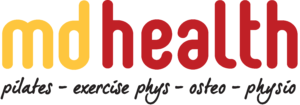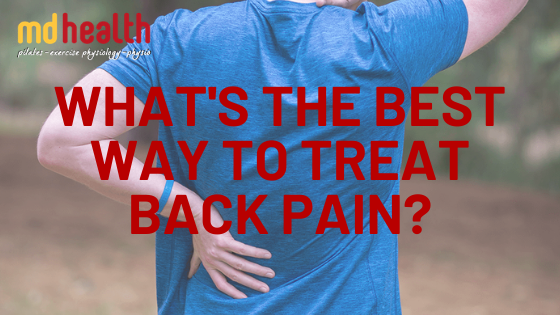Back pain can be debilitating and is becoming a very common experience for people of all ages. But what’s the best way to treat lower back pain?
We are always evolving the way we treat and hopefully prevent lower back pain with our members at MD Health.
This month, we’re focusing on giving all our members an update on the latest understanding and best practices in managing and treating lower back pain.
Diagnosis of lower back pain
By the age of 50, most people will see some changes on MRI scans, however, this may not be the cause of your lower back pain, despite being present on scans. In our experience. These scans can be very useful if they match your symptoms, but be a distraction or lead in the wrong direction if they are NOT consistent with what you are describing. The two must match to be useful. Therefore, whenever you have a new episode of lower back pain, it is important that we assess the back, pelvis (Sacro-iliac joint) and hips. Any of these areas can be the cause of pain at the time and the treatment for each is very different. Based on the findings, we will design the next part of your treatment (both hands-on and exercises) to match the cause of this injury for the fastest and most complete recovery in the long term.
Part 1 of treatment: Strengthen the stabilisers of the lower back – the multifidus muscle
Multifidus, is a small muscle that directly controls the movement of the vertebrae and protects the back from injury. Studies over the last 20 years have consistently found that strengthening this muscle affect the recovery from lower back pain. According to this latest article, new studies are finding the same thing. We have also found that this is not enough. Once this muscle is activated, it is important to also strengthen the power muscles that support the back. These include the gluteus maximus and hamstrings for more complete recovery with exercises such as rack pulls and dead lifts. Our staff at MD Health can guide you through which exercises to do and when and control your progression through these exercises.
Part 2 of treatment: How you perceive your injury makes a difference
It’s not in your head and it is? What does this mean? The anxiety you feel about your injury returning and the fear of the pain itself, will increase your pain and your perception of the disability caused by your pain. It is extremely important to acknowledge the pain and injury, but to keep up the activities you can do within the bound of the injury. Ensuring you still do the things you love to do and are still capable of doing, such as going out to dinner, watching movies you love and meeting up with friends (despite the pain) is very important. All these activities affect how your brain interprets the pain and your long-term recovery. Stopping these activities actually INCREASES your pain and anxiety, by increasing the release of natural cortisol, heightening your brain’s response to pain. Returning slowly and gradually to the things that you love does the opposite and is important for long term recovery.
Part 3 of treatment: What you shouldn’t do about back pain
Complete rest has been shown repeatedly to reduce the size, strength and activation of the multifidus muscle and does nothing for recovery of your back pain in the long term. When healthy, young males were asked to rest in bed for 8 weeks, their multifidus muscles reduced in size and strength and recovery was not complete 6 months later and this was without injury. Moving, getting back to work and returning to your normal life as early as possible aids both physical and mental recovery from injury. Secondly, opioid medication (pain killers), often prescribed for back pain is actually rarely needed. Most injuries will recover better from mild anti-inflammatories (such as voltaren) in the short term. Getting back to in to guided exercises such as activation of multifidus and returning back to normal activities will also help with lower back pain.
Back pain treatment and Clinical Exercise at MD Health
All of our Physiotherapy and Exercise Physiology staff at MD Health are extensively trained in how to manage lower back pain and how to help you achieve long term recovery from lower back pain, so that you not only reduce your pain, but live the life you deserve.
Do you have any questions?
- Call us on (03) 9857 0644 or (07) 3505 1494 (Paddington)
- Email us at admin@mdhealth.com.au
- Check out our other blog posts here
Our clinical staff would be happy to have chat if you have any questions.
Take the first step to a healthier you!
Would you prefer for someone to contact you to book your FREE Full Body Assessment*?
Please fill in this form and someone from MD Health will be in touch with you soon.
Alternatively please call us on:
07 3505 1494 (Paddington – Brisbane (QLD) Clinic)
Or email us:
admin@mdhealth.com.au (VIC) paddington@mdhealth.com.au (QLD)
*Please note only the Full Body Assessment is a FREE service. The Full Body Assessment is for new clients at MD Health or returning clients who haven’t been in for 6 months or longer who intend to particpiate in our 13 Week Clinical Pilates Program**.
For all new clients who wish to come in for a one-off, casual or adhoc basis for Physiotherapy or Exercise Physiology the Initial Physiotherapy or Initial Exercise Physiology appointment is a paid service.
** The 13 Week Clinical Pilates Program at MD Health is not a lock in contract and you are not required to attend for the full 13 weeks if you do not wish.
This site is protected by reCAPTCHA and the Google Privacy Policy and Terms of Service apply.



